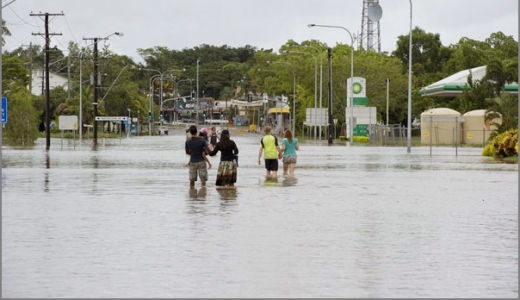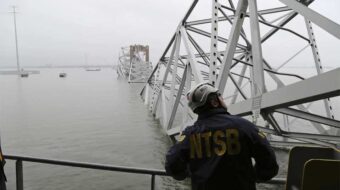
The following is an editorial by Austalia’s Guardian newspaper, the workers’ weekly, on the devastating floods in Queensland.
BRISBANE, Australia — The floods in Queensland and other states have brought tragedy on a massive scale, but also wonderful examples of heroism, cooperation and sacrifice. Volunteers arrived to help from all over the country, and also from other nations. Emergency services and other organizations at all levels of government cooperated and acted with efficiency and dedication. Residents fleeing flooded homes, or returning to begin the heartbreaking task of cleaning up, have often found themselves assisted by total strangers.
A UN official has praised the nation, and the Queensland government and people in particular, for their wonderful performance in dealing with this catastrophe. Nevertheless, the story of the floods includes some official blunders, and has major long-term implications for the entire nation, particularly regarding climate change and environment policies.
Devastation on an unseen scale
The scale of the flood crisis is the greatest in Australia’s recorded history. River height records were broken in most of the towns affected. In Brisbane, the floods did not quite reach the heights of the 1974 floods. However, this was largely because the Wivenhoe dam, built after 1974, retained the water until it nearly reached the top of the dam, forcing authorities to open the sluice gates. If it had not been for the dam the total amount of water reaching Brisbane would have been far greater.
Other states as well as Queensland were also affected. Rivers broke their banks with a vengeance in northern NSW, Victoria, Tasmania and South Australia.
Nor was the flooding limited to Australia, for that matter. Floods have made a million people in Bangladesh homeless, and have killed 355 people in Brazil.
As The Guardian goes to press, 18 people are known to have died and about 60 are missing. Various areas of Queensland are still flooded, and are likely to remain so for several weeks. Floodwaters are still rising in Victoria and South Australia.
That process will be very long, very difficult and very expensive. Damage to crops will result in shortages of fruit and vegetables. The estimated cost of repairing the damage in Queensland alone is $5 billion, and a 0.75 percent rise in inflation is expected.
Planning for the aftermath
Discussion is well underway with regard to recovery and rebuilding in the aftermath of the Queensland crisis. The floods have revealed weaknesses in local and state planning laws and procedures, for example the granting of permission by councils for building development in flood-prone areas. The floods have also demonstrated the importance of public health services and public railways as a means of transport. In one area, with all the roads cut off, a historic rail service proved vital in bringing in emergency service volunteers. Consideration is now being given to construction of a special rail network to service north Queensland coastal areas.
Attention has also been focused on other issues that had a direct bearing on events, for example the rejection by the state government and most Queensland councils of an offer from Telstra of a free emergency warning phone call system for residents in areas threatened with flash flooding.
Residents of Toowoomba suffered the terrible “inland tsunami”, with tragic results, including many casualties. The state emergency services were not able to issue warnings in time. The Telstra service might have done so, but the local Council is said to have failed to respond to the company’s offer at all.
Despite its initial mitigation of the flooding of Brisbane, the Wivenhoe dam proved unable to avert the swamping of low-lying areas. The building of more dams will doubtless be advocated by Labor and Liberal politicians, particularly because of their very cozy relationships with major development and construction corporations.
However, hydrology professor Dr Willem Vervoort has warned against the building of further dams, which he says lull people into a false sense of security. For a start, constructing a dam is extremely expensive, and its effectiveness in dealing with floods is limited by its use for other purposes, for example retaining water for agricultural, domestic or industrial consumption, or for hydro-electricity generation.
Moreover, planning the capacity of dams is not straight forward because climate change is making it difficult to predict the likely frequency or level of future floods. Last, but certainly not least, dams also have severe impacts on the environment, particularly regarding downstream flora and fauna, as demonstrated in the Murray-Darling system.
Other countries are now concentrating on alternative measures to deal with floods. These include the cessation of residential and industrial development in flood-prone areas, increasing surface infiltration, and taking measures to slow the flow of floodwater.
Professor Vervoort has also suggested rerouting floodwaters to less critical areas of floodplains. This also raises the question of redirecting floodwaters above maximum critical levels out of the floodplains altogether, possibly to supplement ailing river systems such as the inland Murray-Darling system.
There has also been much concern about the traumatic effect on people whose homes and workplaces have been damaged or lost in the flooding. Public health is a source of serious concern, as is the difficulty flood victims experience in making insurance claims.
The insurance industry is reluctant to offer cover against floods, and policies that are available are extremely expensive. Moreover, the industry has decided not to offer voluntary (no liability) compensation and it is entirely possible that some companies that have offered flood cover will attempt to dodge any liabilities for compensation arising from their policies.
The changing climate
Prior to the arrival of “white invaders” from Britain, floods were far less frequent in Australia, and were mitigated by the Aboriginal people’s maintenance of a landscape in which the flow of rainwater was slower and far more inclined to permeate the soil. Since then land clearing and mono-cultural crop cultivation on a vast scale, together with the widespread use of fertilizers and pesticides, has altered the soil’s characteristics, and made it susceptible to erosion. Floods are now frequent and savage, and are progressively stripping off the frail and ancient topsoil.
And now we also have the threat of climate change. The scientific discovery of the El Niño and La Niña weather patterns, which bring about Australia’s “droughts and flooding rains,” is only relatively recent. So is the detection of climate change, which some scientists think is now bringing about extreme weather events worldwide, as well as the Australian floods – for example the extremely bitter winters in Britain and Western Europe, which may be a result of the slowdown of the Atlantic Gulf Stream current.
Throughout the flood crisis, mass media news reports barely mentioned climate change. This is astonishing, because for years climatologists have been warning that it is likely to bring about an increase in extreme weather events in certain areas of Australia, particularly the eastern coast and hinterlands, combined with long periods of drought in other regions.
It is ironic that coal mining was one of the industries worst hit by the flood crisis, given that the global emission of vast amounts of carbon dioxide from the industrial combustion of coal is probably humankind’s biggest single contributor to climate change.
Until the floods began, Queensland was supplying almost 25 percent of the world’s sea-borne coal exports, including about half of the world’s coking coal, which is used in the production of steel. Before the floods Queensland Premier Anna Bligh managed to sell off most of the infrastructure for transporting and processing coal. Apart from disposing of tremendously valuable public assets, the government has ensured that the purchasers will be extremely tenacious in maintaining coal as the nation’s primary energy source.
However, much of the rail network used to transport coal to the coastal ports is now in ruins, and many of the mines are inundated or damaged. Coal production has fallen by about 75 percent and it could take a year for full production to be resumed.
It is possible that the shortage of coal arising from the Queensland crisis, combined with the near-certainty of increasingly unstable weather patterns in future, may prompt governments and industrial corporations to begin phasing out the use of coal as an energy source. Who knows, perhaps the tragic 2011 floods will end up helping to save humankind and the rest of the world’s living creatures from the terrible threat of climate change.
Photo: (Via The Guardian)












Comments